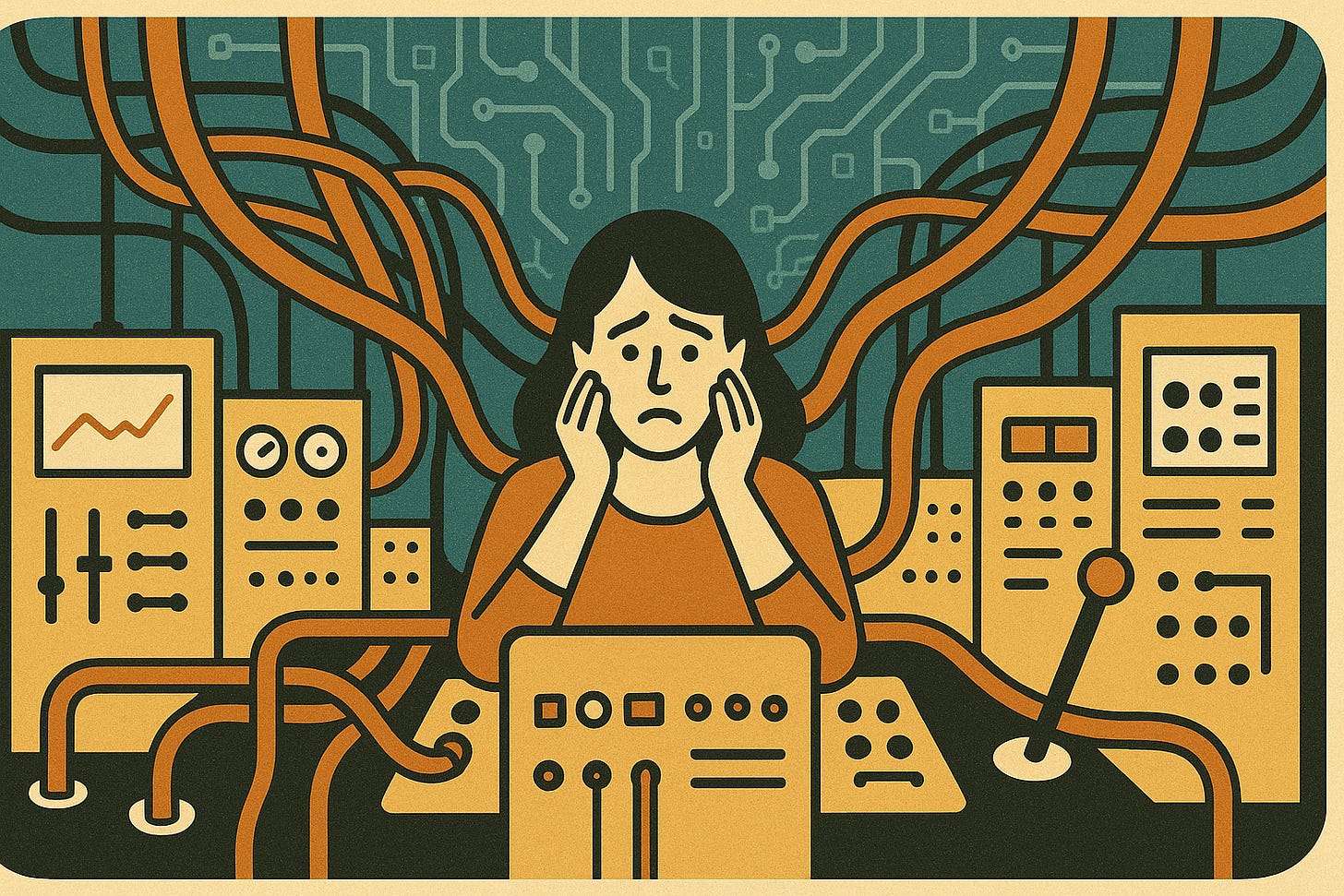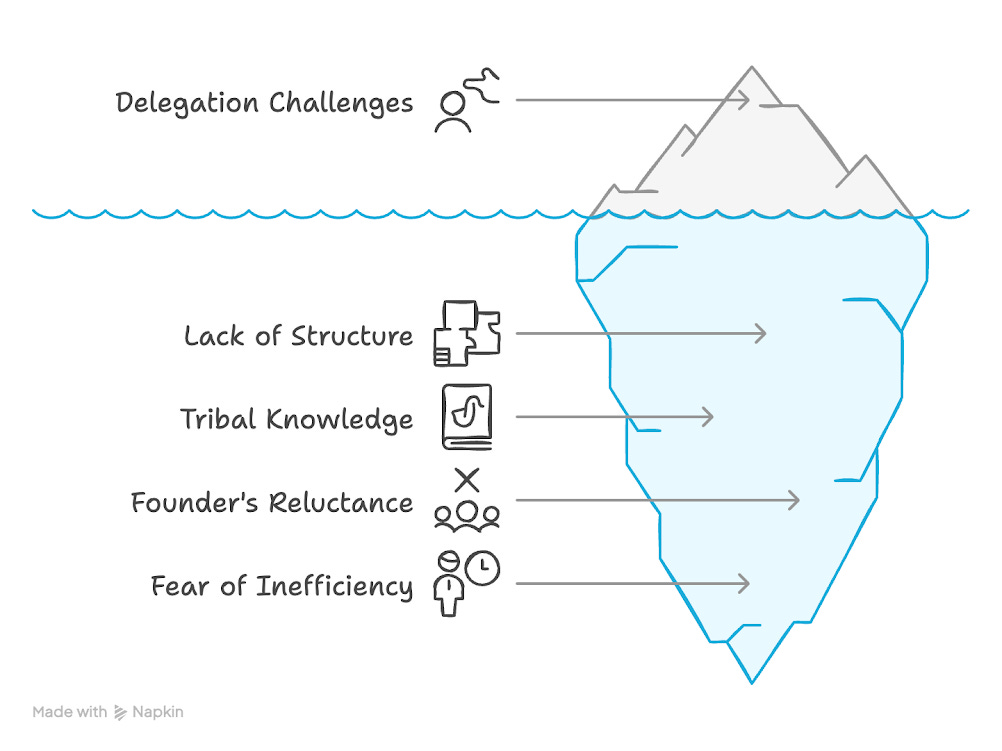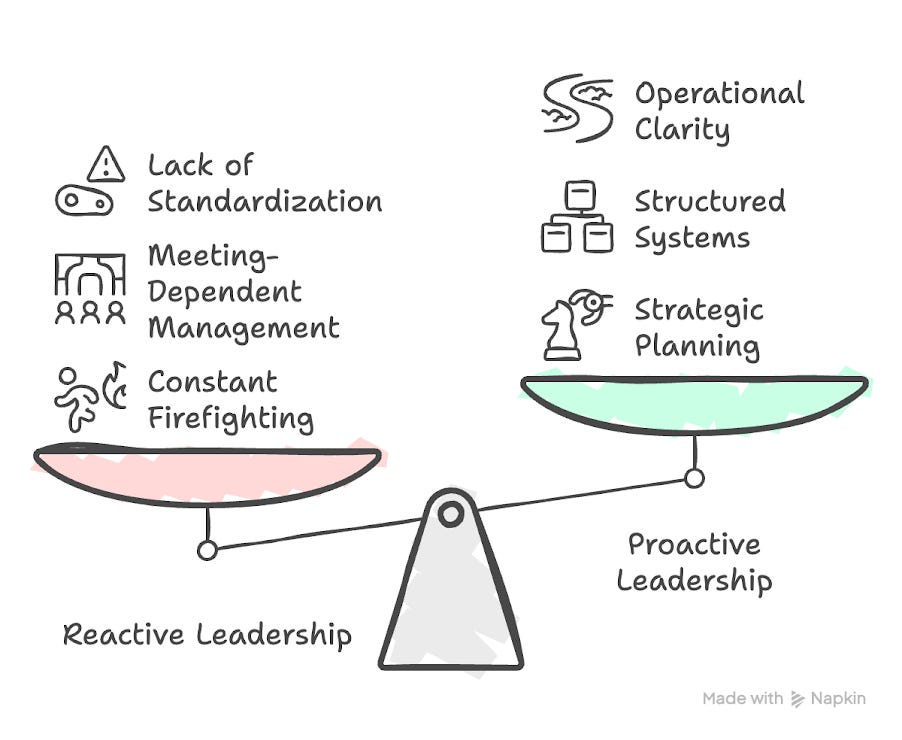TL;DR: If your systems depend on your instincts, your approvals on “gut feel,” and your leadership on firefighting, AI will only expose the cracks.
Every growing business knows brittle workflows stall growth. They turn routine into a slow grind, where every new initiative feels heavier than the last.
What most don’t realize: AI won’t fix these workflows. It only exposes the cracks.
Here’s the pattern I see again and again: owners assume the problem is a weak team member or the wrong tool. So they swap platforms. Or roles. Or entire hires.
(The “maybe we just need a better person in this seat” phase is especially brutal — on morale, trust, and momentum.)
But the real issue runs deeper. It’s the architecture: the invisible systems that decide how choices get made, how progress is measured, and who gets to act.
And when your invisible — but very real — systems rest on proximity, intuition and owner-instinct? AI can’t save you. It will only highlight the gaps.
Let’s look at the delegation, approval, and leadership habits that snap under pressure — and why.
❌ Delegation Habits That Break
Task-level delegation with low context
(”Just do this thing I usually do.”) AI tools — and junior humans — need more structure than “osmosis” provides. And when they operate with low context they won’t know how to handle the little speedbumps that happen in everyday life. And where do they go for their answers? You. (On your side, you’d call this Death by 1000 Cuts).
This kind of delegation silently privileges insiders — people who already know the unwritten rules. That makes it harder for newer or historically excluded team members to succeed without constantly guessing.
Legacy knowledge workflows
If workflows live in an owner’s head or Voxer thread, AI can’t access them to assist or optimize. The knowledge exists — but only as oral tradition, not shared infrastructure. Sure, veteran team members can get their work done, but there’s no chance for technology to play a role — or even someone to step in while others are out.
When knowledge is informal and undocumented, power concentrates in those with tenure or proximity. This limits access, slows onboarding, and makes contribution dependent on gatekeepers.
Delegation by interrupt
Real-time delegation (DMing team members mid-task) leaves no trail for AI to observe, learn from, or support. It also ensures that everything runs at the speed of….your constant availability.
This style of delegation rewards those who are always online and responsive — and penalizes those who work asynchronously or with less schedule flexibility. The result? Invisible bias in who gets looped in, who gets trusted, and who gets left behind.
❌ Approval Systems That Break
Gut-check reviews instead of criteria-based reviews
If work-product (or performance) is evaluated with “feels right” or “I’ll know when I see it,” AI can’t help you measure or improve it. Nor can human team members ever hope to build something to spec without gobs of wasted time and effort, because they can’t even measure it against something to see if they’re close and it’s ready for your eyes.
By the way, this is the one that will make team members leave — especially the high-performers. If you didn’t hire for clairvoyance, you certainly can’t run a team on it.
Vague reviews reward those who already “get” you and penalize those who don’t share your background, communication style, or cultural norms. Lack of criteria means invisible bias wins — and inclusion quietly loses.
No documentation of decision-making rationale
AI thrives on reasoning patterns. If a business can’t explain why a decision was made, AI can’t replicate or augment it. You also will find it difficult to explain your rationale to the humans who might want a peek behind the curtains of how you’re up-ending their lives (again).
Undocumented reasoning concentrates power and obscures logic. It turns leadership into a black box, which erodes trust and transparency — especially for team members who’ve been burned before.
Reviews done as oral debriefs
These are real-time stream-of-consciousness reactions to a work-product, and — for early-stage teams — these make the world go ‘round and are the bread-and-butter of how the team gets work out the door. They are also havens for bias, inconsistency, lack-of-rigor and the vagaries of a low-energy (or high-energy) day. And, as it happens, useless for audit trails or AI training, or even post-mortems.
When feedback lives in spontaneous conversations, there’s no record, no accountability and no shared standard. That puts power in the hands of whoever’s in the room — and leaves others guessing or excluded.
❌ Leadership Habits That Break
Reactive leadership driven by inbox and Slack fires
Ok, we’re all guilty of this one. We all swing at the curveballs life sends us, even when we try to carve room for the “important not urgent” projects that will prevent these from happening so often.
This is so worth getting out in front of, because constant firefighting creates noise. AI needs signal. (And so does your team.)
When everything is reactive, the loudest voice wins. This reinforces proximity bias and undercuts the quieter contributions that come from preparation, not panic.
Relying on meetings to manage work
Presence doesn’t scale, and restricting management (and motivational messages) to synchronous meetings quickly becomes a bottleneck. If team performance relies on your energy, your judgment in real time, or your ability to rally people in the moment, it’s a sign that structure is missing. And AI? It can’t read vibes. It needs clarity, standards and systems to be effective.
Real-time culture rewards extroverts, people in your time zone, and those with high availability. Everyone else has less voice, less access, and fewer chances to lead. That’s not flexible—it’s exclusion in disguise.
Avoidance of standardization in the name of “flexibility”
Using AI doesn’t require 0% nuance in your workflows — but it needs some consistency to be effective. When every project, client, or internal request is handled differently “because we’re flexible,” your systems become unpredictable and untrainable. What feels like adaptability is often a lack of operational clarity — and that doesn’t scale. If there’s no common way to do the work, then no one (human or AI) can step in confidently or improve the process.
Flexibility without clarity privileges those who’ve always known how to read between the lines. For everyone else, the rules feel like a moving target. And that’s not equitable.
The Path Forward
Once you can see these patterns clearly, the path forward becomes a matter of design — not discipline. This isn’t about pushing harder or being more hands-on. It’s about stepping into a new kind of leadership that reshapes how your business functions — so that it’s not only compatible with AI, but poised to fully leverage it.
And just as important — it’s a chance to design a business where clarity, access and shared power aren’t side effects. They’re the foundation.
And that begins with understanding what AI-ready habits actually look like. To be continued….!!







Great, Karen! Artificial intelligence, in itself, doesn’t transform things outright.
Rather, it aids in sharpening our focus on structural challenges and fosters a fairer market – distinguishing, as Jean Baudrillard might say, mere simulacra from genuinely effective innovations.